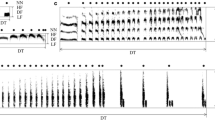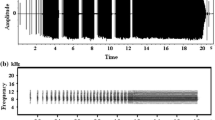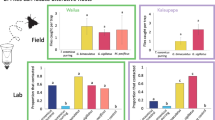‘That songs evolve is not disputed, but that they evolved in certain directions or that song structure is due to the action of certain forces, or that differences are due to random evolutionary events, or that they are the result of selection, or that they arise mainly in association with speciation — these are matters for speculation, debate, and analysis.’
Otte (1992, P. 25)
Summary
Calling characteristics of field crickets (Teleogryllus oceanicus) differ between Pacific populations parasitized and unparasitized by a phonotactic fly (Ormia ochracea). Although we inferred that these song differences were due to natural selection by the fly, other environmental differences among sampling localities may also influence the cricket song. To evaluate the contribution of parasitoid pressure to variation in song structure, we analysed calls of crickets from five areas arrayed along a gradient of prevalence of parasitization. A novel use of canonical correlation analysis allowed us to test simultaneously the robustness of alternative hypotheses and their predictions. There is strong inference that selection pressures by phonotactic parasitoid flies have shaped song characteristics of field crickets in the Hawaiian Islands. Not all song components appear to have been equally affected by parasitoid selection and approximately 80–90% of total song variation among individuals is associated with other, unmeasured ecological and environmental attributes.
Similar content being viewed by others
References
Allen, T.H.F. and Starr, T.B. (1983)Hierarchy:Perspectives for Ecological Complexity. University of Chicago Press, Chicago, IL.
Cade, W. (1975) Acoustically orienting parasitoids: fly phonotaxis to cricket song.Science 190 1312–13.
Cade, W. and Wyatt, D.R. (1984) Factors affecting calling behaviour in field crickets,Teleogryllus andGryllus (age, weight, density, and parasites).Behaviour 88 61–75.
Cooley, W.W. and Lohnes, P.R. (1971)Multivariate Data Analysis. John Wiley, New York, NY.
Dayton, P.K. and Tegner, M.J. (1984) The importance of scale in community ecology: a kelp forest example with terrestrial analogs. InA new ecology: novel approaches to interactive systems (P.W. Price, C.N. Slobodchikoff and W.S. Gaud, eds), pp. 457–81. John Wiley, New York, NY.
Kevan, D.K. McE. (1990) Introduced crickets and grasshoppers in Micronesia.Boletin de Sanidad Vegetal Plagas (Fuera de serie)20 105–23.
Otte, D. (1992) Evolution of cricket songs.J. Orthopt. Res. 1 25–49.
Otte, D. and Alexander, R.D. (1983) The Australian crickets (Orthoptera: Gryllidae).Acad. Natl Sci. Philadelphia Monogr. 22.
Robert, D., Amoroso, J. and Hoy, R.R. (1992) The evolutionary convergence of hearing in a parasitoid fly and its cricket host.Science 258 1135–7.
Ryan, M. (1985)The Tungara Frog:A Study in Sexual Selection and Communication. University of Chicago Press, Chicago, IL.
Sabrosky, C.W. (1953a) Taxonomy and host relations of the tribe Ormiini in the western hemisphere.Proc. Entomol. Soc. Washington 55 167–83.
Sabrosky, C.W. (1953b) Taxonomy and host relations of the tribe Ormiini in the western hemisphere II.Proc. Entomol. Soc. Washington 55 289–305.
Sakaluk, S.K. (1990) Sexual selection and predation: balancing reproductive and survival needs. InInsect defenses (D.L. Evans and J.O. Schmidt, eds), pp. 63–90. SUNY, New York, NY.
SAS Institute Inc. (1988)SAS/STAT User's Guide, Release 6.03 Edition. SAS Institute, Cary, NC.
Stewart, D.K. and Love, W.A. (1968) A general canonical correlation index.Psychol. Bull. 70 160–3.
Tabachnick, B.G. and Fidell, L.S. (1983)Using Multivariate Statistics. Harper and Row, New York, NY.
Walker, T.J. (1975) Effects of temperature on rates in poikilotherm nervous systems: evidence from the calling songs of meadow katydids (Orthoptera: Tettigoniidae:Orchelimum) and reanalysis of published data.J. Comp. Physiol. 101 57–69.
Walker, T.J. (1983) Diel patterns of calling in nocturnal orthoptera. InOrthopteran mating systems:sexual competition in a diverse group of insects (D.T. Gwynne and G.K. Morris, eds), pp. 45–72. Westview Press, Boulder, CO.
Walker, T.J. (1993) Phonotaxis in femaleOrmia ochracea (Diptera: Tachinidae), a parasitoid of field crickets.J. Insect Behav. 6 389–410.
Walker, T.J. and Wineriter, S.A. (1991) Hosts of a phonotactic parasitoid and levels of parasitism (Diptera: Tachinidae:Ormia ochracea).Fla. Entomol. 74 554–9.
Wiens, J.A., Rotenberry, J.T. and Van Horne, B. (1987) Habitat occupancy patterns of shrubsteppe birds: the effects of spatial scale.Oikos 48 132–47.
Zuk, M., Simmons, L.W. and Cupp, L. (1993) Calling characteristics of parasitized and unparasitized populations of the field cricketTeleogryllus oceanicus.Behav. Ecol. Sociobiol. 33 339–43.
Zuk. M., Simmons, L.W. and Rotenberry, J.T. (1995) Parasitization of calling and silent males in the field cricketTeleogryllus oceanicus by an acoustically-orienting parasitoid.Ecol. Entomol. in press.
Author information
Authors and Affiliations
Rights and permissions
About this article
Cite this article
Rotenberry, J.T., Zuk, M., Simmons, L.W. et al. Phonotactic parasitoids and cricket song structure: An evaluation of alternative hypotheses. Evol Ecol 10, 233–243 (1996). https://doi.org/10.1007/BF01237681
Issue Date:
DOI: https://doi.org/10.1007/BF01237681




